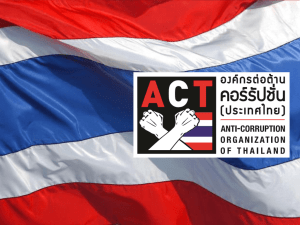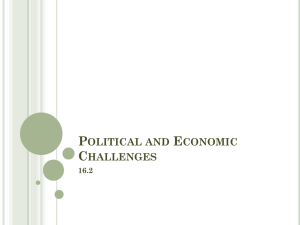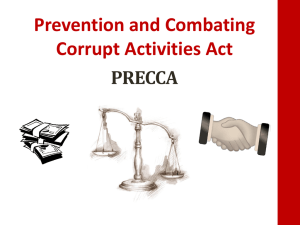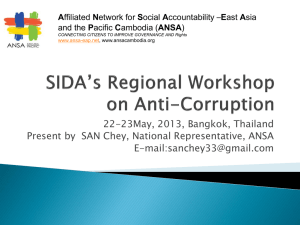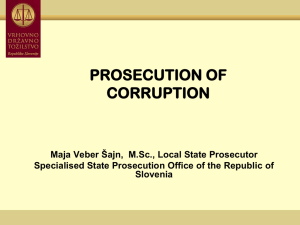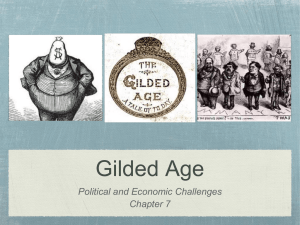Combating corruption - Governance Assessment Portal
advertisement
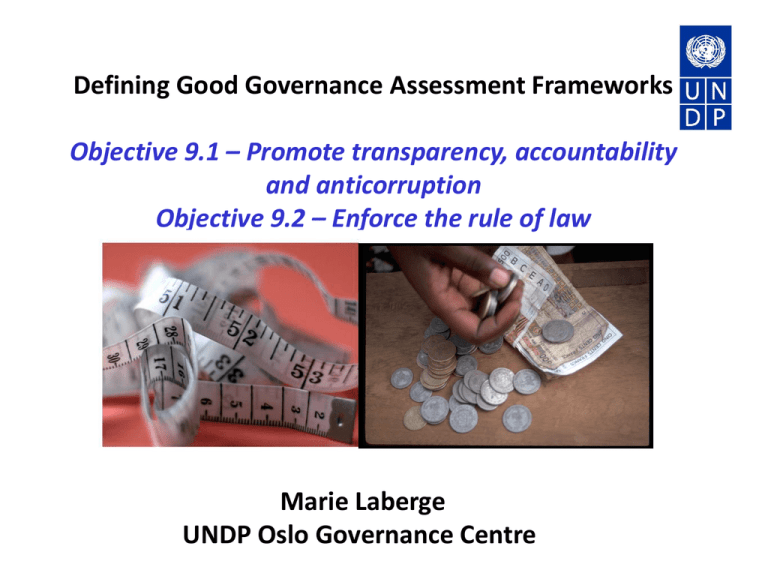
Defining Good Governance Assessment Frameworks Objective 9.1 – Promote transparency, accountability and anticorruption Objective 9.2 – Enforce the rule of law Marie Laberge UNDP Oslo Governance Centre Objective 9.1 – Promote transparency, accountability and anticorruption • Users’ Guide to Measuring Corruption • How to measure integrity (as opposed to corruption) • Survey data: Public servants (Afghanistan) Users’ Guide to Measuring Corruption (2008) By UNDP & Global Integrity Literature review of best practices for corruption measurement, and classification of existing tools Based on the views of professionals tasked with measuring corruption Identifies good practices Case studies Key Findings • Practitioners want actionable data, and existing global indicators are inadequate. • Perception-based data viewed as the least useful data when perceptions measured are ‘external’. However, perceptions of local actors can be useful. • Indicators customized to country specificities are most useful and seen as more ‘credible’ by policymakers Corruption indicators -Number of reported cases of bribery within the police -Police ranked as second most corrupt institution in national perception surveys -Bribe payments as % of income among individuals in low-income districts - Existence of safe corruption reporting mechanisms - Proportion of registered complaints that have resulted in sanctions Corruption indicators can measure… 1. The incidence of corrupt transactions experience & perception data 2. The impact of corruption data sensitive to vulnerable groups & gender 3. The effectiveness of anti-corruption mechanisms ‘integrity indicators’ How to measure ‘integrity’ – as opposed to corruption? • Rather than measuring the "cancer" of corruption let’s assess the quality of the "medicine" being applied to fight it: anti-corruption mechanisms •The Global Integrity Framework measures: the existence (in law) the effectiveness (in practice) and citizen access to key anti-corruption mechanisms •Type of data used: Fact-based, supported by objective evidence (laws, official policy documents, newspaper articles, administrative data, independent reports, academic sources, etc.) Framework to measure integrity (existence, effectiveness and citizen access to anti-corruption mechanisms) 1. Civil society, public information and media CSOs media public access to information 2. Elections voting & citizen participation integrity of elections regulations around political financing 3. Government accountability executive accountability legislative accountability judicial accountability budget process Framework to measure integrity (existence, effectiveness and citizen access to anti-corruption mechanisms) 4. Administration and civil service civil service regulations whistle-blowing measures procurement privatization 5. Oversight and regulation national ombudsman supreme audit institution taxes & customs state-owned enterprises business licensing and regulation 6. Anti-corruption and rule of law anti-corruption law anti-corruption agency rule of law Example: To assess whistle-blower measures (Administration & Civil Service): 1. In law, is there an internal mechanism (i.e. phone hotline, e-mail address, local office) through which civil servants can report corruption? 2. In practice, is this internal mechanism effective? (outcome) •In practice, the internal reporting mechanism has a professional, full-time staff? (input) •In practice, the internal reporting mechanism receives regular funding? (input) •In practice, the internal reporting mechanism acts on complaints within a reasonable time period? (process) •In practice, when necessary, the internal reporting mechanism initiates investigations? (output) Designing integrity indicators: Afghanistan Indicator 7: State-public interface •Site observation to measure the extent to which fees for the delivery of public services (e.g. heath, driver’s license), and a functioning telephone number where complaints can be lodged, are posted in publicly visible places, at the site where civil servants interact directly with the public • What sites to sample? All ministries that have a direct service delivery function Addresses of service delivery locations 7 sites randomly selected for each ministry Designing integrity indicators: Afghanistan Observation protocol: 1. Printed fee schedule? 2. Method to lodge complaints? (phone number to call, designated responsible person) 3. Clearly posted? 4. Complaints mechanism is functional? (number actively in service?) Scores assigned from 0 – 10, based on the above criteria What do you think…? • Perceptions are better indicators of progress than facts • Facts are better indicators of progress than perceptions • Both perceptions and fact-based indicators are useful • Neither is helpful, it is not possible to measure corruption How can perception data help or hinder corruption monitoring? Drawbacks of perception data • Seen as biased, leading some to minimize its use, or rule it out entirely • Politically sensitive, especially in polarized political climates, where the media is influential • Lag effect: perceptions often lag behind reforms But perception data matters! • High perceptions of corruption (even if not justified) are correlated with low perceptions of state legitimacy • High perceptions can fuel corrupt practices by: • encouraging people to believe they must pay bribes • reducing the likelihood of citizens reporting • leading those with power to believe that there is nothing wrong with accepting bribes. • Perceptions and opinion reveal important information about how corruption works in a specific context Afghan Civil Servant Corruption Survey A) Perceptions of corruption in the civil service: • Perceptions of the extent of corruption • Perceptions regarding whether exposing acts of corruption would hurt the civil servant’s career. If perceptions of corruption are high: lowers the barriers to corruption (such as guilt, fear of punishment, reputational harms) increases corrupt practices Afghan Civil Servant Corruption Survey B) Conceptions of corruption in the civil service: • Do they align with definition of corruption in AC reforms? (e.g. can civil servants recognize acts of corruption from a given list?) • Personal attitudes and beliefs may dominate legal definitions of corruption... If discrepancy between civil servant conceptions of corruption and the law: promotes transgressions and will undermine reform efforts Afghan Civil Servant Corruption Survey C) Tolerance of corruption in the civil service: • Extent to which certain corrupt practices are considered acceptable within the civil servant’s values system or justified as a display of hospitality or gratitude for efforts of the civil servants. If tolerance of corruption is high: Raises the probability that a civil servant will participate in corrupt acts Reduces the probability that corrupt acts will be exposed Afghan public servant survey: Tolerance of corruption in the civil service Example: Please indicate how much do you agree with the following statements: • I would feel comfortable helping my family member get a job in my govt office, provided they were qualified. • …even if they were not as qualified as another candidate. • I would feel obligated to use my influence as a civil servant to help my friend / relative with a problem if I could. • Corruption by low-level employees is more acceptable than corruption by high-level officials. “Strong and accountable institutions” Calculations ARAB DEMOCRACY INDEX Indicator 12: ‘Government accountability’ No. of proposed votes of + 250 points for each no confidence in the vote of no confidence government officials no. of investigations into + 50 points for each government investigation no. of fact-finding committees formed + 50 points for each fact-finding committee no. of cases in which government officials were questioned + 1 point for each question put to an official Data sources 1) Parliament (including Secretariat) 2) Reports by CSOs 3) Media “Strong and accountable institutions” (Arab Democracy Index)” Some indicators from the opinion poll Indicator 16: The public’s perceptions of the use of wasta in employment in the public sector (governmental institutions, institutions financed from the state budget such as the parliament, the president’s office and local government authorities, etc.) Indicator 20: The public’s belief that the executive authority is introducing political reforms or that there is a genuine interest on its part to do so

